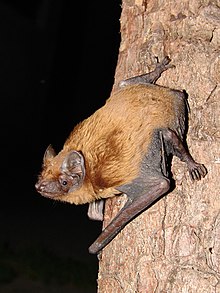Common noctule
This article includes a list of general references, but it lacks sufficient corresponding inline citations. (November 2015) |
| Common noctule | |
|---|---|

| |
| Scientific classification | |
| Kingdom: | |
| Phylum: | |
| Class: | |
| Order: | |
| Family: | |
| Genus: | |
| Species: | N. noctula
|
| Binomial name | |
| Nyctalus noctula Schreber, 1774
| |
The common noctule (Nyctalus noctula) is a species of bat common throughout Europe, Asia, and North Africa. The UK distribution can be found on the National Biodiversity Network website here.
With a length of 8 cm and a wingspan of 35 cm, the common noctule bat is one of the largest in western and central Europe. When hunting, it often starts flying in early dusk, earlier than most European bats. It flies high above the forested areas that are its preferred habitat, reaching speeds of up to 50 km/h.[2] Small to medium-sized woodlands are preferred but they may forage up to 20 km from the woodland at night. When roosting through the day, the noctule bat usually seeks out tree holes or even bat boxes attached to the tree trunks.
Generally noctule bats live in forests, but some populations can be found in towns. There are many noctules in Hamburg, Vienna, Brno and some other central European cities.
In addition to the typical ultrasounds the noctule bat may expel shrill cries; this is a mating call.[3] Common noctule bats mainly eat beetles, moths and winged ants.
Noctule bats hibernate in winter, and sometimes congregate in hibernation colonies of up to 1000 individuals. Tree holes are not warm enough so they search caves or objects like church steeples. Sometimes summer territories and hibernating places are hundreds of kilometres apart.
The common noctule bat is declining but the other European noctules are even rarer. The lesser noctule and the giant noctule live in forests only and never in towns.[citation needed]
Echolocation
The noctule uses two main calls for echolocation. The frequencies of the first are 26–47 kHz, have most energy at 27 kHz and an average duration of 11.5ms.[4] The frequency of the second call is 22–33 kHz, having most energy at 22 kHz and an average duration of 13.8ms.[4][5]
Breeding
During the summer, male noctules are solitary or form small bachelor groups.
References
- ^ Template:IUCN2006
- ^ "Noctule Bat Factsheet". bats.org.uk. Retrieved 2011-04-18.
- ^ Woodland Management For Bats Guide
- ^ a b Parsons, S.; Jones, G. (2000). "Acoustic identification of twelve species of echolocating bat by discriminant function analysis and artificial neural networks". J Exp Biol. 203 (Pt 17): 2641–2656. PMID 10934005.
- ^ Obrist, M.K.; Boesch, R.; Flückiger, P.F. (2004). "Variability in echolocation call design of 26 Swiss bat species: Consequences, limits and options for automated field identification with a synergic pattern recognition approach". Mammalia. 68 (4): 307–32. doi:10.1515/mamm.2004.030.
{{cite journal}}: Unknown parameter|last-author-amp=ignored (|name-list-style=suggested) (help)

